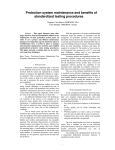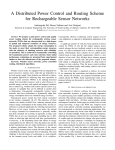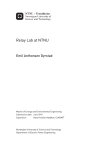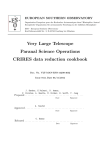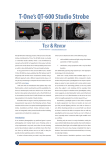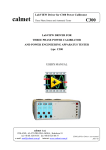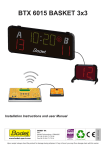Download Electrical power standards 2010-08
Transcript
Electrical Power Standards Andrzej Olencki, Jan Szmytkiewicz, and Krzysztof Urbański Abstract – In the University Zielona Gora (Poland) and Calmet Ltd, a Three Phase Power and Energy Calibrator and Tester – Portable Electrical Power Standard was developed for the calibration and test of a wide range of electrical metering instrumentation. This paper gives a summary of the theoretical and practical details of the project. Index Terms – Calibrators, Power Quality Measurements, Energy Meter testing, Protection Relay Test Set, automated calibrations I. INTRODUCTION Typical multifunction calibrators can generate only one quantity at time – voltage or current. For many applications are needed precision sources with more than one channel with accurately generated value of voltage or current [1]. Practically in the laboratories are used two or six channels calibrators. The so-called Single Phase Power Calibrator (SPPC) has two outputs and can generate at the same time AC voltage and current. Also the phase angle between them can be set with high accuracy, so we get possibility of power simulation. The six channels version can generate three voltages shifted usually by 120° and 240° or with programmed value of angle between voltages and three currents shifted like the voltages plus an additional phase shift between the voltage and the current. Such system, called the Three Phase Power Calibrator (TPPC), allows for a three phase power network simulation. The SPPC and TPPC can be applied for adjustment and testing measurement equipment, especially electricity meters and power network analyzers [2]. They can generate reference vectors of the voltage and current which are shown in Fig. 1. U1 I1 U1; U2; U3 I1; I2; I3 ϕ1; ϕ2; ϕ3 ∠ ) U2;U1 ) U2;U1 ∠ ∠ ) U3;U1 ϕ1 ) U3;U1 ∠ I3 U3 ϕ3 phase voltage phase current phase shift angle shift between voltage U2 and U1 angle shift between voltage U3 and U1 ϕ2 I2 U2 Fig. 1. Vector diagram of the TPPC output II. TPPC DEVELOPMENT History of the TPPC development is shown in Table 1. First in the World TPPC was introduced in 1976 (the 800 by ROTEK USA [3]). Probably the first in the Europe TPPC was developed by our team and was introduced in 1988 (the SQ33 by LUMEL Poland, actually a product named Inmel 33). The ROTEK 800 was developed as the SPPC in single case, which may be configured to operate in single or multi-phase configuration. The complete three phase system comprises three cases of the SPPC (the construction version 3xSPPC=TPPC). This design solution ROTEK is used in the models 8000 and 8100 [11] and FLUKE used in the model 6100A [4]. The SQ33 calibrator was developed as the TPPC in single case (the construction version 1xTPPC=TPPC). Our experience with this construction version (light weight and small dimensions, simple and economy construction) made possible to develop the first portable TPPC with current range up to 100A introduced in 2006 (model C300 by CALMET Poland [5]). Table 1. Development of the TPPC IntroConduc- Model Weigh struction name t [kg] tion date Rotek 1976 3 case 800 Lumel 1988 SQ33 / 1x45 1 case +P Inmel =45 33 Calmet 1993 3x14 C233 3 case +P =42 C233B Rotek 1995 3 case 8000 Fluke 2003 6100A +P 6130A/ 3 case 3x30 80A =90 2005 Inmel 1x45 1 case +A 8033 =45 Rotek ? 8100 +P 8100-3- 3 case 3x25 P =75 2006 Calmet 1x32 1 case +P C300 =32 P – actually produced Current range [A] Feed- Errors @ 230V/5A/50Hz back δP@ ∆ϕ δI con- δU PF=1 [ppm] [ppm] [°] verter [ppm] A/A 50 A/A 608 700 2150 0,320 100 A/A 1800 700 2500 0,500 A/D 279 154 260 A/D 520 600 1087 0,100 A/D 135 144 126 0,003 A/A 509 520 500 0,100 A/D 80 50 55 100 0,003 Table 1 consists of the following modern Electrical Power Standards (EPS): • the FLUKE 6100A model high accurate EPS for stationary utilization, • the ROTEK 8100 model high accurate EPS for stationary utilization, • the CALMET C300 model medium accurate and economy EPS for portable and stationary used. The modern EPS is a TPPC with additional features: • Power Quality Source (PQS) function enables: o generation of special voltage and current waveforms (harmonics, interharmonics and special shapes functions), o simulation of voltage and current variations as a function of time (ramp functions), • Automatic Test System (ATS) function for checking of electricity meters, measurement of industrial transducers, current clamps, current transformers and protection relays, in a fully automatic way (impulse counter, AC/DC voltage/current measurement and timer functions). III. EPS AS A POWER QUALITY SOURCE The EPS provides the functions required for a full test of power quality meters with compliance to the requirements of standards defining power quality measurement methods such as EN 610004-30. To both the voltage and current of the reference vector diagram in Fig.1 may be added Harmonics, Interharmonics (compliance to the EN 61000-4-7) and even Fluctuating Harmonics or Notching. In the addition to the values of amplitude and phase of harmonics (frequency, amplitude and phase of interharmonics) programmed by the user, the EPS can show calculated values of Crest Factor CF, Shape Factor SF, Total Harmonic Distortion THD, Total Distortion Factor TDF and Total Interharmonic Distortion TID. Using a Ramp function, both the voltage and current outputs can be configured to reproduce Dips, Swells, Interruptions and Flicker Pst or Plt coefficients (compliance to the EN 61000-415) independently on the voltage and current outputs. Additionally, the EPS provides specific wave shapes such as those defined by the EN 61036 and EN 50470 for energy meters, for example Phase Fired or Burst Fired signals. Most of those signal types are available simultaneously, so it is possible to get very complex signals. Error Err +∆XLIM 0,4 0,3 0,2 0,1 XM 0,0 -0,1 0 -0,2 1 2 3 4 5 6 7 8 9 10 −∆XLIM -0,3 -0,4 IV. EPS AS AN AUTOMATIC TEST SYSTEM The idea of a connection TPPC and additional meters with a computer equipped with specialized ATS software gives a new kind of device – Three Phase Power Automatic Test System. In Fig. 2 this calibration and test system, with the C300 EPS, is presented. This system consists of the C300 EPS, PC with Calpro 300 Software and Device Under Test (DUT). The DUT may be an electricity meter or measurement transducer, current clamp, current transformer or protective relay. The C300 EPS has a precision TPPC and a set of additional inputs and meters: • the impulse counter for counting the impulses from electricity meters, • the U/I meter – a DC voltmeter for measuring the signals from industrial measurement transducers or DC current clamps and an AC ammeter for measuring the signals from AC current clamps or current transformers for measurements, • the timer for the output state sensing from protective relays [6]. Computer with Calpro 300 Software C300 Electrical Power Standard Device Under Test TPPC Response time t R [s] 100,000 1,000 Electricity Meter U/I Meter Measurement Transducer tRMIN 0,100 0,010 0,001 1 10 100 XM Threshold TH 7 6 5 4 3 2 1 0 -1 -2 -3 -4 -5 -6 -7 THMAX THMIN -5 Impulse Counter tRMAX 10,000 -4 -3 -2 -1 0 1 2 3 4 Parameter P 5 Fig. 3. Characteristics of the DUT: (a) error curves, (b) response time curves, (c) threshold values curves for example the R-X dia- Current Clamps Current Transformer Timer Protective Relay gram of any distance relay Error characteristics (Fig. 3a) are measured by means of steady state testing. Output quantities can either be entered in the classical way as voltage, current, phase angle values, or by using continuous step/ramp modes. In this test the TPPC of the EPS works in a static mode with extremely high accuracy. The test results are correct for the following requirements: − ∆X LIM ( X M ) < Err ( X M ) < + ∆X LIM ( X M ) Fig. 2. Fully Automatic Test System with the C300 EPS This system can be used for measurements of three kinds of calibration characteristics in a fully automatic way: • error curves (in Fig. 3a) of electricity meters, measurement transducers, current clamps and measurement transformers, • response time (trigger time) curves (in Fig. 3b) of protective relays, , • threshold values (trigger level) curves (in Fig. 3c) of protective relays. (1) where XM is the measured value, that is generate by the EPS and ∆XLIM(XM) is limit of errors. There are many different methods available for the relay tester depending on testing equipment features [6]. Steady state testing including continuous step/ramp mode operation is provided for finding limiting values, such as pick up and drop off, or starting of a relay. It is usually used for threshold value curve tests of the relays with a single protection function and with only a single zone of protection. More elegant dynamic testing, including pulse ramping [7], dynamic on/off, dynamic simple and dynamic complex [6] methods, is used to determine response time curves (see Fig. 3b) of the relays and threshold value curves of all relays including multi-zone distance relays. In this test the TPPC of the EPS works in dynamic mode with extremely short response time. The C300 EPS uses the static and dynamic on/off method for de- termine of the relay's protection curves. In dynamic on/off testing a pretest value is zero and it is suddenly (with 0,001 second response time for C300 EPS) increased to the test value, for example up to 100A. The test results are correct for the following requirements: t RMIN ( X M ) < t R ( X M ) < t RMAX ( X M ) (2) and TH MIN ( X M ) < TH ( X M ) < TH MAX ( X M ) . (3) The error, response time and threshold values characteristics can be presented as a graph or a table. Efficient testing and performance analysis require well-defined limit values ∆XLIM in Fig. 3a and recommended protection curves and limit values tRMIN , tRMAX , THMIN , THMAX in Fig. 3bc. V. EPS’s PRINCIPLE OF OPERATION Fig. 4 presents a circuit block diagram of the SPPC. The structure can be divided into a digital part with a control unit CU and an analog-to-digital part. This part consists of a generator G, a phase shifter PS, a voltage output stage VOS and a current output stage COS. From the control unit to the digital-to-analog part of the calibrator are connected signals as follows: the setting of a voltage RMS value (U), the setting of a current RMS value (I), the setting of a phase shift of a fundamental frequency (ϕ), and the setting of a fundamental frequency (f). Optionally, the control unit may also permit the user to define a specific wave shape of the voltage and/or current, number, amplitude and phase of harmonics, frequency, amplitude and phase of interharmonics on the voltage and current outputs. AU/D Σ setting U AU/A U VOS setting f G AI/D CU setting ϕ Σ AI/A PS setting I Σ Digital part I COS ϕ/D Digital-to-Analog part Fig. 4. Structural scheme of a SPPC At the calibrator’s terminals, active power is simulated according to the equation: P = U ⋅ I ⋅ cosϕ (4) with error given by: δP = δU + ∆U U + δI + ∆I I + cos(ϕ + ∆ϕ ) − cos ϕ cos ϕ (5) where δU, ∆U represent the multiplicative and the additive part of the voltage error, δI, ∆I represent the multiplicative and the additive part of the current error and ∆ϕ is the error of the phase shift. To minimize the active power error δP (5), in the SPPC are used the close loops for stabilisation of the voltage, current magnitude and phase shift value. Two typical ways of stabilising the voltage and current magnitudes are illustrated in Fig 4. In one way, a feedback path consists of an Analogue-to-Analogue Converter AU/A in the voltage feedback and an AI/A in the current feedback. This technology named as Analog Technology is implemented in the Calmet C300 EPS (in Table 1 the column named as "Feedback converter") with using modern RMS/DC converters, DAC's in adders Σ for comparing the setting with the feedback signals from proportional plus integral feedback control system (with using PI controller) and with digital correction of a nonlinearity. In the other, the feedback path consists of an Analogue-to Digital Converter AU/D in the voltage feedback and an AI/D in the current feedback. This technology named as Digital Technology is implemented in the ROTEK 8100 and FLUKE 6100A EPS with using modern DSP processors and is patented by Rotek in 1997 [8] and Fluke in 2005 [9]. Practically in all modern EPS's, digital technology with DSP processors are used for the phase angle and the angle between voltages stabilisation. The phase angle between the voltage U and the current I from the calibrator outputs is converted by the phase shift angle converter ϕ/D to digital code and is compared with the phase angle setting. The result of the comparison, as a phase error, is added in the adder Σ to the main signal setting ϕ. This idea was patented by authors in 1994 [10] and is implemented in the Polish SPPC and TPPC. In the first Polish TPPC series SQ33 is used microprocessor's technology, and in the INMEL 8033 and CALMET C300 is used DSP technology (see Table 1). VI. ALTERNATIVES TO THE EPS For many applications there is a need a precision multi channel source of AC voltage, current and phase angle, for example in the calibration and test of the measurement transducers and meters of power network parameters, electricity meters, current transformers, protection relays, and in the recent years power quality meters. Traditionally, for calibration each kind of those devices are used in different kinds of measurement instruments. The measurement transducers and meters of power network parameters and power quality meters, recorders and analysers are tested by means of the power calibrators (TPPC from Table 1). Electricity meters calibrations are mainly performed by using the energy comparison method (as named the reference meter method too). A known amount of energy generated from a three phase phantom power is simultaneously supplied to a reference electricity meter and the DUT. The modern reference electricity meters consists of a device for counting pulses from the DUT, which calculates and indicates an error of the DUT. It can also display the phase diagrams for quick orientation in the positions of the generated signals and to calculate and display the frequency spectrum of the generated signals. The three phase portable test systems for the automatic testing of a single energy meter, which consists of an integrated three phase voltage and a current source and a three phase reference meter are produced by a few firms, for example RADIAN, ZERA, MTE. This system is named as the Meter Test System, Energy Meter Tester, Test Bench. For electricity meter calibrations may be used the energy calibrator method. In this applications, the calibrator is equipped with the Impulse Counter (see Fig. 2) to receive pulses from the DUT and it is then able to calculate energy recorded by the DUT (according to the meter constant entered by the user), compare this against energy it has delivered, then calculates and display DUT errors. The TPPC can be used in following testing modes: the Count/Time Mode for verify energy meters from their inputs to the impulse output and the Energy Packet Mode (also known as Dose Mode) for verify energy meters from their inputs to the counting device. In the Dose mode, the power from the calibrator's output is generated during set period of time to deliver the requested amount of energy to the DUT. The energy calibrator method for testing electricity meters with the describe modes are used for a long time. Firstly it was implemented 30-ty years ago in the ROTEK 800 and 20-ty years ago by authors in the LUMEL’s SQ33 TPPC. Electricity meter testing typically falls into the following categories: • type testing/approval and service testing/calibration many different types in small amount of the DUT with recommended to use the EPS or a single position Test Bench, • service testing/calibration and particularly manufacturing testing with recommended to use a multi position Test Bench. Current transformer testers (also known as the Current Transformer Test Set or Test Bench) are used by electric utilities to verify accuracy of the transformers for measurement of an electric energy. The current generating range should be from 100A up to 2000A for measure an instrument transformer ratio and phase angle errors. The C300 high current EPS may be used only to 100A200A-300A primary current transformer testing in their full current range. In this applications, the calibrator is equipped with 5A or 1A current range the I Meter (in Fig. 2) for secondary current measurement. Multi turn coils (with 5/10/20/50/100/200 turns) in conjunction with the EPS or a single output current calibrator are used as a tool for the calibrating AC current clamps up to 3000A. In this applications, the calibrator is equipped with the AC I Meter for current output clamps and with the AC U Meter for voltage output clamps (in Fig. 2). Portable protection relay test sets for the automatic testing of all kinds of relays are produced by a few firm, for example ISA, MEGGER, OMICRON. Some features required to test over 90% of relay applications include [6]: • a three phase voltage and current source with independent controls for a phase angle, magnitude and frequency, • at least 25 Amps per channel in the three phase configuration and 75 Amps in the parallel single phase configuration, • a normally open/closed and/or voltage sensing input for timing, • at least one normally open/closed output contact to simulate a breaker status, • independent pre-fault and fault modes for dynamic testing. The perfect test set features include a multiphase source with 4 independent voltage and 7 independent current sources up to 50 Amps per phase in a three phase system. The TPPC with a long setting time typically 1 second, may be used for the pick up tests in continuous step/ramp mode operations and for timing tests in the dynamic on/off mode. In this applications, the calibrator is equipped with the Timer for relay state sensing (in Fig 2). VII. FUNCTIONALITY OF THE EPS Advanced relay testers are designed for calibrating of electrical apparatus, such as: energy meters, instrument transformers, transducers, power quality meters. Comparison table (Table 2) of the EPS functions shows, that the TPPC and the advanced relay testers are physical models of an electrical power network designed to the automatic calibration and test of a wide range electrical metering instrumentation. Table 2. Comparison table of the EPS functions Function Harmonics Fluctuating Harmonics Interharmonics Notching Dips Swells Interruptions Flicker Calibrators Relay testers Calmet ISA Omicron Rotek Fluke DRTS6 CMC C300 8100 Protection 256plus Three 6100A Power ElectriPhase Relay Test Protection and Encal Power Set and Relay Test ergy Measure- Set and Calibrator Power CalibraStandard and ment Sys- Universal tor tem Tester Calibrator PQS functions √ √ √ √ √ √ √ √ √ √ √ √ √ √ √ √ √ √ √ √ √ √ √ √ √ √ √ √ √ √ √ √ √ Energy Meters Transducers Transformers Clamps Relays √ √ √ √ √ ATS functions √ √ - √ √ √ √ √ √ √ √ Harmonics, interharmonics and notching functions are generated by their adding to the magnitude of the voltage or current. Fluctuations, dips, swells, interruptions and flicker functions are realised by using the step or ramp operations for one or more parameters as voltage/current magnitude, frequency, phase angle or harmonics simultaneously. High accuracy devices as the ROTEK 8100 or the FLUKE 6100A traditionally have a large size of a front panel and may be equipped with a large display and a keyboard. Medium accuracy and small size portable devices as the CALMET 300, ISA DRTS6 or OMICRON CMC 256 plus with many additional terminals needed for realisation the ATS functions, particularly for relay testing, are designed to the programmed only from a special PC software with a user interface allowing manual and full calibrations of the DUT. Features of the Calibrators and Testers become similar. Names of this devices become similar, for example the Protection Relay Test Set CMC 256 names as the Universal Calibrator too and the Three Phase Power Calibrator C 300 names as the Tester too. VIII. CONCLUSION The C300 Three Phase Power Calibrator has been designed and introduced as portable medium 0,05% accuracy, comprehensive and flexible source of electrical power signals. This single instrument in many applications replaces the complicated high weight, big size and high cost combinations of individual Single Phase Calibrators and Auxiliary Power Amplifiers required to calibrate wide range of electrical metering instrumentation up to 100A in three phase configurations. REFERENCES [1] A. Carullo, F. Ferraris, M. Parvis and A. Vallan, "Phantom power generator for the calibration of wattmeters in distorted environments," in Proc. IMECO TC-4 Symp. Development in Digital Measuring Instrumentation and 3-rd Workshop ADC Modelling and Testing, Naples, Italy, 1998, pp.67-71. [2] D. Coombes, "Improving accuracy of power quality measurements," Fluke Precision Measurement Hurricane Way, Norwich, UK, http://assets.fluke.com. [3] About Us. Rotek, USA, http://www.rotek.com. [4] The Fluke 6100A Electrical Power Standard. Fluke, USA, http://ca.fluke.com. [5] Three phase power calibrator and power engineering apparatus tester. User's manual. Calmet, Poland, http://www.calmet.com.pl. [6] Ch. Werstiuk, The relay testing handbook: Principles of relay testing. Valence Electrical Training Services, USA, 2008. [7] B. Bastigkeit, Testing the pick-up value of overlapping protection elements/functions without changing the parameter settings: Omicron Electronics – User conference, 2002. [8] A. Gubisch, J. West, P. Miljanic, P. Lualdi, "Precision voltage/current/power source," United States Patent US 5,642,300, Jun. 24, 1997. [9] P. Harbord, A. Fields, "Method and apparatus for generating an electronic test signal," United States Patent US 6,944,569, Sep. 13, 2005. [10] A. Olencki, K. Urbanski, "Three phase calibrator," Polish Patent PL 163006, Jan. 31, 1994. [11] Model 8100 Power and Energy Calibrator. Operator manual. Rotek, USA.




